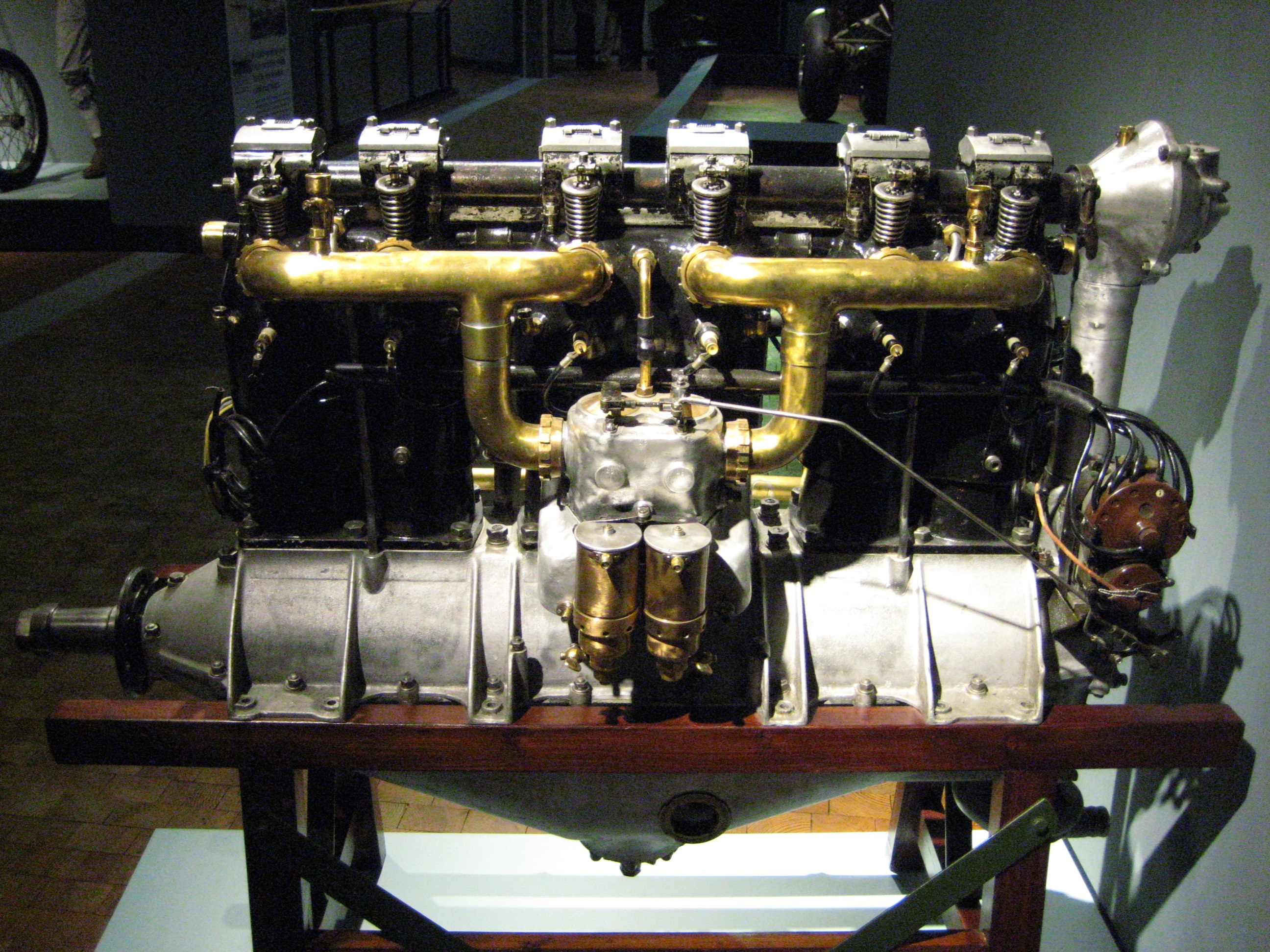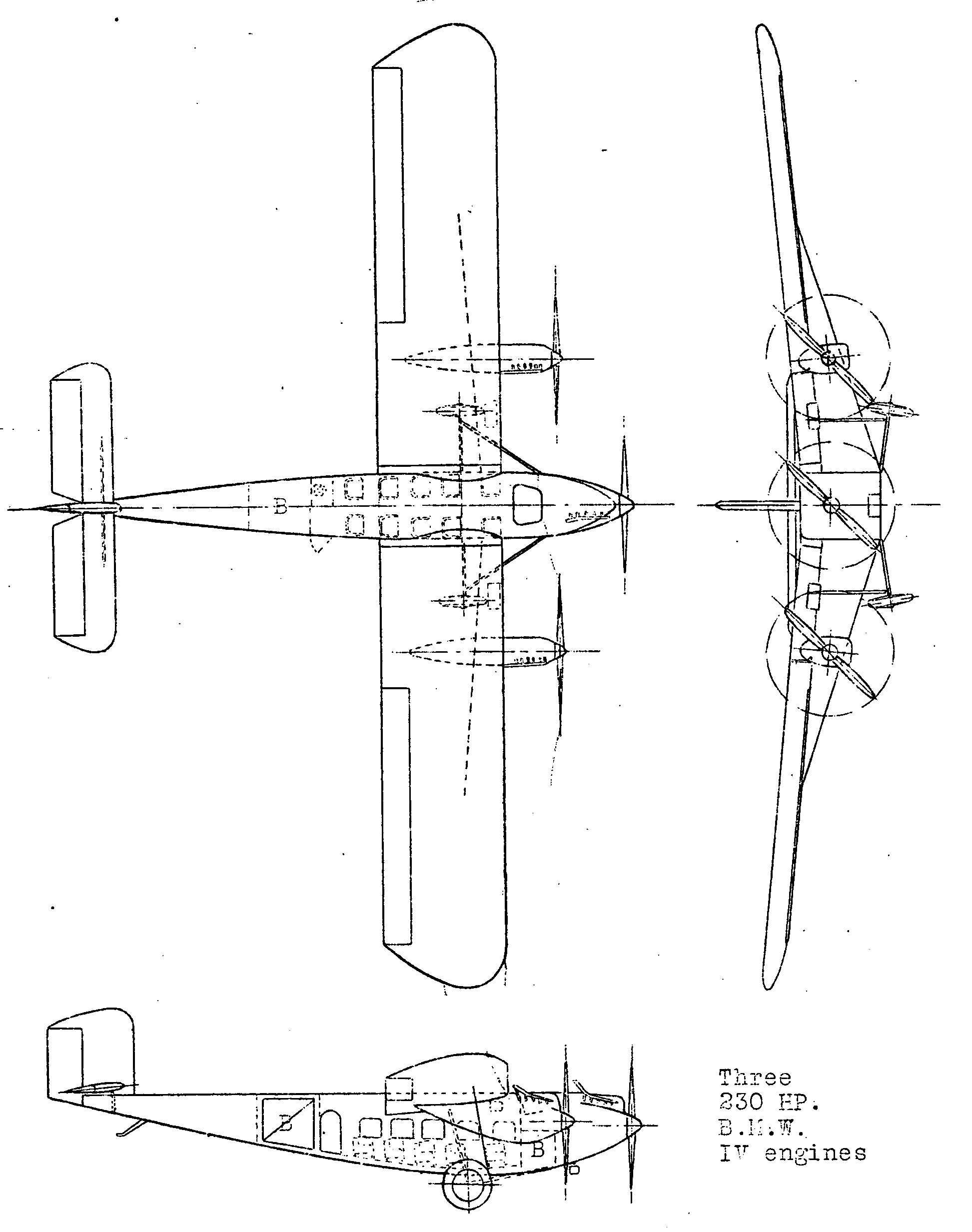|
Junkers L5
The Junkers L 5 was a six-cylinder, water-cooled, inline engine for aircraft built in Germany during the 1920s. First run in 1925, it was a much enlarged development of the Junkers L2. Design and development The Junkers L5 was a development of Junkers' first water-cooled engine, the L2, but at four times the swept volume was a much more powerful engine. It was a water-cooled upright inline 6-cylinder unit, four-stroke and petrol-fuelled, with a capacity of nearly 23 litres. It adopted some of the L2 features, having twin exhaust and inlet valves in each cylinderdriven by an overhead camshaft, twin spark plugs and twin magnetos. The splash component of the L2's lubrication was abandoned in favour of a completely forced recirculating system. The twin carburettors of the L2 were replaced with a single float chamber, dual-venturi model. Like the L2, the L5 was a direct drive engine. The compression ratio of the standard version was 5.5:1, but variants had other ratios to cope ... [...More Info...] [...Related Items...] OR: [Wikipedia] [Google] [Baidu] |
Inline Engine (aviation)
In aviation, an inline engine is a reciprocating engine with banks of cylinders, one behind another, rather than rows of cylinders, with each bank having any number of cylinders, although more than six is uncommon. The major reciprocating-engine alternative configuration is the radial engine, where the cylinders are placed in a circular or "star" arrangement. The term "inline" is used somewhat differently for aircraft engines than automotive engines. For automotive engines, the term ‘inline’ refers only to straight engines (those with a single bank of cylinders). But for aircraft, ‘inline’ can also refer to engines which are not of the straight configuration, such as V, H, or horizontally opposed. Inline engine configurations ; Straight: Engines with a single bank of cylinders which can be arranged at any angle but typically upright or inverted, (e.g. upright ADC Cirrus, inverted de Havilland Gipsy Major). ; V:Engines with two banks of cylinders with less than 180° b ... [...More Info...] [...Related Items...] OR: [Wikipedia] [Google] [Baidu] |
Heinkel HD 42
The Heinkel HD 42 50, later designated the Heinkel He 42 was a German two-seat biplane seaplane originally designed for the ''Deutsche Verkehrsfliegerschule'', and later built for the German ''Luftwaffe''. The aircraft was used until the end of World War II as a trainer for maritime pilots. Design and development In 1929, Heinkel developed a biplane, the HD 42, for use with the covert military-training organization ''Deutsche Verkehrsfliegerschule'' (DVS). Its fuselage was constructed out of a welded steel tube truss and had a rectangular cross-section with a rounded top. The engine covers were made out of light-weight metal, while the rest of the fuselage was covered in fabric. The aircraft was equipped with floats. The HD 42 model received good feedback from the Swedish Navy, who had purchased the aircraft, as well as from the famous pilot Gunther Plüschow (who was the first airman to fly over the Patagonian mountains of Chile and Argentina at Tierra del Fuego). The prototyp ... [...More Info...] [...Related Items...] OR: [Wikipedia] [Google] [Baidu] |
List Of Aircraft Engines
This is an alphabetical list of aircraft engines by manufacturer. 0–9 2si * 2si 215 * 2si 230 * 2si 430 * 2si 460 * 2si 500 * 2si 540 *2si 690 3W ''Source: RMV'' *3W 106iB2 *3W-110 *3W-112 *3W-170 *3W-210 *3W-220 A Abadal (Francisco Serramalera Abadal) *Abadal Y-12 350/400 hp ABC ''Source: Lumsden.'' * ABC 8 hp * ABC 30hp V-4 * ABC 45hp V-6 * ABC 60hp V-8 * ABC 85hp V-6 * ABC 100hp V-8 * ABC 115 hp * ABC 170hp V-12 * ABC 225hp V-16 * ABC Dragonfly *ABC Gadfly *ABC Gnat * ABC Hornet *ABC Mosquito * ABC Scorpion * ABC Wasp *ABC type 10 APU *ABC type 11 APU ABECO ''Source: RMV'' *ABECO GEM Aberg ''Source: RMV'' *Type Sklenar ABLE ''Source: RMV'', Able Experimental Aircraft Engine Co. (Able Experimental Aircraft Engine Co., Altimizer, Hoverhawk (US)) *ABLE 2275 *ABLE 2500 *ABLE VW x 2 Geared Drive Accurate Automation Corp *Accurate Automation AT-1500 *Accurate Automation AT-1700 Ace (Ace American Engr Corp, Horace Keane Aeroplane Co, North ... [...More Info...] [...Related Items...] OR: [Wikipedia] [Google] [Baidu] |
WikiProject Aircraft
A WikiProject, or Wikiproject, is a Wikimedia movement affinity group for contributors with shared goals. WikiProjects are prevalent within the largest wiki, Wikipedia, and exist to varying degrees within Wikimedia project, sister projects such as Wiktionary, Wikiquote, Wikidata, and Wikisource. They also exist in different languages, and translation of articles is a form of their collaboration. During the COVID-19 pandemic, CBS News noted the role of Wikipedia's WikiProject Medicine in maintaining the accuracy of articles related to the disease. Another WikiProject that has drawn attention is WikiProject Women Scientists, which was profiled by ''Smithsonian Magazine, Smithsonian'' for its efforts to improve coverage of women scientists which the profile noted had "helped increase the number of female scientists on Wikipedia from around 1,600 to over 5,000". On Wikipedia Some Wikipedia WikiProjects are substantial enough to engage in cooperative activities with outside organization ... [...More Info...] [...Related Items...] OR: [Wikipedia] [Google] [Baidu] |
Junkers L 5 Im Technikmuseum Hugo Junkers Dessau 2010-08-06 02
Junkers Flugzeug- und Motorenwerke AG (JFM, earlier JCO or JKO in World War I, English: Junkers Aircraft and Motor Works) more commonly Junkers , was a major German aircraft and aircraft engine manufacturer. It was founded there in Dessau, Germany, in 1895 by Hugo Junkers, initially manufacturing boilers and radiators. During World War I and following the war, the company became famous for its pioneering all-metal aircraft. During World War II the company produced the German army's Luftwaffe planes, as well as piston and jet aircraft engines, albeit in the absence of its founder, who had been removed by the Nazis in 1934. History Early inter-war period In the immediate post-war era, Junkers used their J8 layout as the basis for the F-13, first flown on 25 June 1919 and certified airworthy in July of the same year. This four passenger monoplane was the world's first all-metal airliner. Of note, in addition to significant European sales, some twenty-five of these airplanes we ... [...More Info...] [...Related Items...] OR: [Wikipedia] [Google] [Baidu] |
Rohrbach Roland
The Rohrbach Ro VIII Roland was an airliner produced in Germany during the 1920s. It was a conventional strut-braced, high-wing monoplane, based loosely on the Zeppelin-Staaken E-4/20 that Adolf Rohrbach designed in 1920. It had a fully enclosed flight deck and passenger cabin, and featured fixed, tailskid undercarriage. Power was supplied by three engines, one in the nose, and two mounted in nacelles on the wings. Construction was of metal throughout. Design and development In 1926 Deutsche Luft Hansa purchased the prototype Roland, followed by five production examples over that year and the next.Munson 1982, p.138 The production machines were built with open flight decks, although they were later enclosed, as on the prototype. These were put to work servicing a route between Berlin and London via Hanover and Amsterdam. In July 1927 the Roland held the world endurance record for a payload of 1,000 kg with a flight of 14 hours 23 minutes, and the world distance record for a ... [...More Info...] [...Related Items...] OR: [Wikipedia] [Google] [Baidu] |
Messerschmitt M 24
__NOTOC__ The Messerschmitt M 24, otherwise known as the BFW M.24, was an airliner developed in Germany in the late 1920sTaylor 1989, 651 as a further development in the series of designs produced by Messerschmitt, based on the M 18.''The Illustrated Encyclopedia of Aircraft'', 2459 Like the M 18 and its follow-on, the M 20, it was a high-wing cantilever monoplane with a fully enclosed cabin and fixed tailwheel undercarriage. It was slightly smaller than the M 20, seating only eight passengers instead of the ten that could be carried by the previous aircraft. Two prototypes were initially built with BMW and Junkers inline engines, followed by two more with BMW-built Pratt & Whitney radials. However, Messerschmitt proved unable to sell the design, possibly due at least in part to the enmity of Deutsche Luft Hansa director Erhard Milch towards Messerschmitt.Szegeti 1998, 74 The first M 24a (Junkers-engined, registered ''D-1767'') was used commercially from 1930 by Nordbayer ... [...More Info...] [...Related Items...] OR: [Wikipedia] [Google] [Baidu] |
Junkers W 33
The Junkers W 33 was a German 1920s single-engine low-wing monoplane transport aircraft that followed Junkers standard practice making extensive use of corrugated aluminium alloy over an aluminium alloy tube frame, that was developed from the similar but slightly smaller Junkers F 13, and evolved into the similar W 34. One example, named ''Bremen'' was the first aircraft to complete the much more difficult east–west non-stop heavier-than-air crossing of the Atlantic. Design and development Like all Junkers designs from the J 7 fighter onwards, it used an duraluminum aluminium alloy structure covered with Junkers' characteristic corrugated dural skin. While the Junkers W 33 was unusual when compared to the contemporary biplanes in use in the UK and the US, cantilever monoplanes were a popular design choice in continental Europe during the period, and the Junkers designs were unusual only in their extensive use of closely corrugated metal skins. Unlike the skins on the contem ... [...More Info...] [...Related Items...] OR: [Wikipedia] [Google] [Baidu] |
Junkers G 31
The Junkers G 31 was an advanced tri-motor airliner produced in small numbers in Germany in the 1920s. Like other Junkers types, it was an all-metal, low-wing cantilever monoplane. In the mid-1920s, the all-metal construction and an aerodynamically 'clean' configuration were remarkable. Development Professor Junkers wanted to follow up on the commercial success of the tri-motor G 24 with a new design that would be larger, more comfortable for passengers, and simpler to operate and maintain.Wolfgang Wagner "''Hugo Junkers'' Pionier der Luftfahrt – Seine Flugzeuge" Bernard & Graefe Verlag, Bonn 1996 (in German) The G 31 was the first Luft Hansa airliner to feature a flight attendant (Wagner p. 264), who served food and drinks (which were not complimentary). This earned the G 31 the nickname 'flying dining car' ('fliegender Speisewagen' in German). Because of its large fuselage it was also called the flying moving van ('fliegender Möbelwagen' in German). Behind the cockpi ... [...More Info...] [...Related Items...] OR: [Wikipedia] [Google] [Baidu] |
Junkers K 30
The Junkers G 24 was a German three-engine, all-metal low-wing monoplane passenger aircraft manufactured by Junkers from 1925. Junkers F 24 was the designation for single-engine versions of the same aircraft. Design and development The increased German air traffic in the 1920s led to a requirement for a larger passenger transport aircraft. The G 24 was an enlarged development of the F 13. It was originally designed by Ernst Zindel as a single-engine aircraft. Under the restrictions imposed on aircraft in Germany by the Treaty of Versailles, only low powered engines were allowed. So the Junkers company designed their large G24 airliner to be single-engined, but built it as a tri-motor. With three low powered engines the G24 could fly, but was not a viable airliner. The plan was to sell the tri-motors to airlines outside of Germany, who would then install a single, high-powered engine (e.g. 450 hp Napier Lion) on the nose, and simply remove the wing center-section plugs that ... [...More Info...] [...Related Items...] OR: [Wikipedia] [Google] [Baidu] |







.jpg)